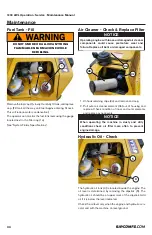
1800 AWL Operation · Service · Maintenance Manual
800.392.2686
21
Safety
• NEVER tow without properly installed tire straps and
vehicle-in-tow security chains.
• DO NOT tow the trailer unless the tongue jack is fully
raised off The ground
• NEVER allow passengers to ride on the trailer.
No open or soft-top sport utility vehicle is allowed to tow
a trailer, because in the event of a crash, these vehicles
offer less collision and ejection protection.
Your Tow Vehicle
Refer to the owner’s manual, decal instructions or an
authorized automotive dealer for any specific handling
characteristics of your tow vehicle.
Changes to your tow vehicle from how it was manufactured
can affect its ability to tow. These changes can include different
tires, suspension changes, etc. Check your owner’s manual
or with an authorized automotive dealer to make sure any
changes to your tow vehicle are approved. DO NOT tow the
trailer if your tow vehicle has changes that are not approved.
Avoid driving on a compact spare tire any longer than
necessary. Follow the vehicle manufacturer instructions.
Maintenance and condition of your tow vehicle’s engine,
transmission, steering, suspension, front-end alignment, and
tires, may affect the vehicle’s ability to tow the auto transport
trailer. Have an authorized repair facility inspect and repair
your vehicle BEFORE towing.
To find the capabilities of the engine, transmission and axles
of your vehicle for towing, refer to the owner’s manual, or
check with an authorized dealer.
Towing Equipment Requirements
Hitches must be able to tow the weight of your trailer and
your vehicle-in-tow .
When towing a trailer, all lights must be operational. Also,
your tow vehicle may require external mirrors on both sides.
Tire Pressure
Set all tires to the proper pressure. Find the recommended
COLD pressures on the tire sidewall, owner’s manual,
your vehicle’s door decal or in the trailer manual. DO NOT
put more pressure in the tire than is indicated on the tire
sidewall. Tire pressures go up during driving. DO NOT let
off this extra pressure.
Air pressure in the rear tires of some tow vehicles may be
increased to accommodate the additional weight of the trailer.
Inflate rear tires approximately 6 psi above normal, but do
not exceed the pressure limit stamped on tire.
Connecting Your Trailer
Lower the coupler onto the hitch-ball and follow the
instructions below to properly fasten the coupler to the hitch-
ball. Do not allow your self to become distracted. Ensure
that the coupler is properly fastened to the hitch-ball before
moving to the next step.
COUPLER- Push down on the latch and fully open the
coupling. Lower the coupler onto the hitch-ball.
Check that the ball clamp is positioned below the coupler. The
coupler should completely cover and enclose the hitch-ball.
Tighten the coupler latch down.
Move the tow vehicle forward slightly, or push rearward on
the trailer to ensure that the hitch-ball is properly seated
inside the coupler. Recheck that it is tight.
Check all connections at each stop. Make sure the hitch and
hitch-ball are securely attached to your tow vehicle and the
trailer coupler is properly connected to the hitch-ball. Use the
checklist at the end of these instructions. If you suspect or
detect something is wrong, contact the nearest Rayco Dealer.
Safety Chains
The purpose of the safety chains is to keep the trailer
connected to your tow vehicle in the unlikely event the coupler
comes off the ball or the ball comes off the hitch. Safety chains
are attached to the trailer tongue and are equipped with hooks.
DO NOT tow the trailer without the safety chains securely
attached to the towing vehicle. DO NOT attempt to pull the
trailer by the safety chains alone, unless this is necessary to
get the combination off the roadway to a safe place.
The left chain crosses underneath the trailer tongue and hooks
to the right side of the tow vehicle permanent hitch, frame
or structure, or to the tow vehicle bumper brackets. Do not
attach chains to the ball or to a ball mount that is removable.
The right chain hooks to the left side in the same manner.
Crossing the chains under the tongue allows the minimum
amount of slack for turning. Control slack by hooking the
chain back to itself or by twisting the links to shorten chain.
Be sure the hooks are secured.
The chains need slack to allow your vehicle to make turns.
Make sure these chains attach securely to your tow vehicle
and do not drag on the roadway.
Emergency Brake Cable/Chain
Trailers with brakes have a third chain, called the emergency
brake chain. This chain applies the brakes automatically in
the unlikely event of a separation of the trailer from the tow
vehicle. Attach this chain as close to the vehicle center
as possible; to the tow vehicle permanent hitch, frame or
structure, or to the bumper brackets. Twist chain to take
up most of the slack and secure. Some slack is necessary
































